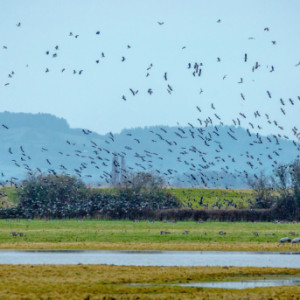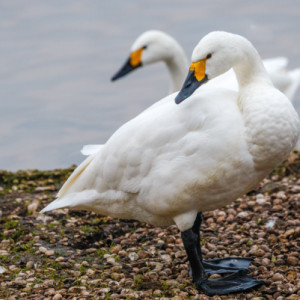A Bewick's swan on the Rushy hide at Slimbridge
This morning Helena said that she’d like to visit the daily mass bird feeding held at dusk on the Rushy hide at Wildfowl and Wetland Trust, Slimbridge. What a good idea, I agreed.
We set off on the eight mile drive after 2-30pm but managed to be inside the large site before 3-15pm. The already overcast sky was beginning to get darker. Helena wanted to explore more of the site so we separated and I headed off to the Robbie Garnett hide which I knew would give wide views across the meadows towards the River Severn. As we’d driven up to the centre we saw at least five huge flocks in the sky of differing birds so I hoped I might see them.
As I looked towards the distant boundaries along the protective flood prevention wall forming the bank of the River Severn, I saw flocks of Brent Geese and a few Bewick Swans as well as two cranes grazing on the often flooded grass meadows. Around them were large flocks of lapwings. In the first extra you can see the flock after being startled and all taking to the air in a mass formation.
Not long after I walked back to meet Helena at the Peng Observatory, which has a ground floor room looking out over the carefully prepared Rushy Hide, designed specifically for the care of masses of wild birds. The depth of the water, the shapes of small island and prepared meadows all offer the best environment for visiting birds to get both protection and nurturing.
At 4pm a warden comes into the observatory, introduces himself and starts to provide a commentary on what us visitors can see through the large glass windows. After a few minutes describing the scene and talking particularly about the famous Bewick's swans, he heads outside to deliver a wheelbarrow full of bird food to the water’s edge where he progressively walks around the lake throwing scoops of seeds to the seething throngs of birds.
It was already very dark by this time so my pictures of the feeding session were not useable as we near mid-winter. I think we will come back nearer the end of January, which is when he recommended as the best time to see the masses of the varied winter migrants on the whole site, especially down by the river.
I’ve added a couple of 'Extras' – a shelduck, the distant flock of lapwings, as well as a pair of Bewick’s. But my main photo is of the first Bewick’s swan I saw when I entered the observatory standing alone on a small island of pebbles looking straight at the glass in front of me. I think they are the most attractive of all swans I’ve seen and appear to be far less aggressive than the dominant and native mute swans. Apparently the yellow markings on each bird’s beak are wholly unique and each bird can be identified by the wardens who look after them, and they know the names given to them. I think this one might have been ‘Maisie’, who is at least twenty-five years old. It seems to have been a good breeding season for the breed this year. There are only about 17,000 of them. These birds tend to mate in northern Russia in the Arctic Circle and migrate back and forth.




Comments
Sign in or get an account to comment.


